-
Membership
Membership
Anyone with an interest in the history of the built environment is welcome to join the Society of Architectural Historians -
Conferences
Conferences
SAH Annual International Conferences bring members together for scholarly exchange and networking -
Publications
Publications
Through print and digital publications, SAH documents the history of the built environment and disseminates scholarship -
Programs
Programs
SAH promotes meaningful engagement with the history of the built environment through its programs -
Jobs & Opportunities
Jobs & Opportunities
SAH provides resources, fellowships, and grants to help further your career and professional life -
Support
Support
We invite you to support the educational mission of SAH by making a gift, becoming a member, or volunteering -
About
About
SAH promotes the study, interpretation, and conservation of the built environment worldwide for the benefit of all
Reflections on Indigeneity, circumpolarity, oral history making, and architecture—in a comparative framework
Adil Mansure is a 2022 recipient of the H. Allen Brooks Travelling Fellowship. All photographs are by the author, except where otherwise specified.
Various Indigenous peoples have dwelt for thousands of years along the Arctic circle. Here, time, frost, and colonial oppression have inevitably vetted out stellar models of living sustainably. What are these architectures of adaptation, buoyancy, and persistence? And what about them don’t we still understand and are not able to pin—and pen—down? Many of these peoples never took to writing or drawing, yet, their elders, who they deem to be spiritual librarians of their communities, transfer thousands of years of architectural knowledge through their stories. This traditional and ecological knowledge is rich, holistic, and not siloed into narrow knowledge domains; architecture, too, is a phase in the life cycle of carbon chemistry involving food, clothing, energy, and shelter. Architecture is thus important in mitigating change pertaining to migration, climate, and resource management, and not merely an outcome of industrial production. For this traveling fellowship, I sought to speak to the elders and knowledge-keepers of various Indigenous peoples about the architectural knowledge that lay intertwined in their stories, myth, and worldviews. It is precisely in the ‘unwritten-ness’ of their knowledge that its adaptability and sustainability lies—and this oral epistemological format thus compels an ‘oral history’ project. Given similarities in climate and other geographical conditions along similar latitudes, and also to some extent similarities in how Indigenous peoples were colonized, I proposed a comparative, circumpolar, oral history project. Thanks to the H. Allen Brooks Travelling Fellowship, I traveled to Iceland to talk to the Icelanders, to Southern Yukon to talk to various Yukon First Nations, and to Haida Gwaii to talk to the Haida.
I want to use this brief essay to discuss some ideas common to the various conversations I have had during my travels. Examples that discuss these themes in further detail can be found in each of the monthly fellowship reports I have written, which I will point to in this essay. I also want to note that, like previous reports, any accounts I am sharing are deliberately being kept anonymous. This report is not the space to disclose personal stories or make ‘human subjects’ out of the people who were kind enough to have conversations with me. I have made promises to not record or transcribe, but simply describe through abstract and third-person narratives, the attitudes and ideas that have struck me as most remarkable.
I must clarify first that I am not myself Indigenous, and prior to these travels, knew little about the Indigenous communities I wished to speak to for this oral history project. I am of Indian and Pakistani origin, belonging to an Indian minority, and now a Canadian minority. Being from a colony of the British empire, I relate somewhat to the oppression that many Indigenous communities have endured on the grounds of language, race, religion, public identity, and spatial expression. Language is particularly important here, both from a personal and global perspective. I think of English as my second language—‘second,’ however, not to any one ‘first.’ And this is something that I have discovered to share with several elders and artists of the Indigenous communities I have spoken with. The imposition of English upon the now-Canadian First Nations and banning the use of their languages—especially in the residential schools that Indigenous children were coerced into—was a major weapon of colonization that even today continues to manifest its deleterious effects. The Indigenous communities I have spoken to are now witnessing a crucial multi-generational void, and ruptures of both a cultural and an epistemic nature. Where then might strands of continuity be found for the fostering and regeneration of Indigenous traditional knowledge and culture?
Not by any means a scholar of Indigenous culture or architecture, I came to this project primarily with an interest in and some prior work on language and space. I am deeply interested in how world-building occurs primarily through language. Not only are we compelled to language from our very beginnings, but we make sense of the world significantly through the terms of common parlance. In Louis Althusser’s terms, we are interpellated by language; that is we become ourselves as mediated through and by the languages we speak.1 However, we are not only shaped by language, we also simultaneously and collectively shape the languages we speak. Personalities are influenced and shaped by, but by no means entirely decided by language. Like any technology—architecture included—creation and identity occur and recur in the interstices between the coda of any convention. This nature of language, this shared technology abundant with entropy, is not only incredibly complex but also mysterious and intriguing to study—especially in the language uses of the Canadian Indigenous peoples I have spoken to, even in their use of English. With them, it is evident that ‘meaning’ lies beyond and in-between their common symbols, structures, grammar, and rules of language use, and it is only by engaging with them personally that I have even a slight understanding of their culture and knowledge. So with language, we find ourselves to be in a double bind: we approach community and culture through language, we shape it and are shaped by it, but ultimately we reach that point where we know that what lies beyond escapes it. It forms both the local and general at the same time. How language escapes the symbolic for the peoples I have met interests me very much, since I conjecture that architectural knowledge tests the symbolic in similar ways. Language, engaged with in this way is precisely what it shares with architecture: it yields the very spaces where we can model how we are immersed in our societies, technology, cultures, and indeed the environment.
I chose to begin in Iceland; an unconventional choice, one might think, given that Icelanders might not be considered to be Indigenous, per se. However, as I explained in my first SAH fellowship report—beyond being a sub-Arctic land sharing geographical similarities with other Indigenous communities I spoke to—not only does the island have a history of austerity, impoverishment, and (soft) colonization, but furthermore, it has a unique history of literary arts (evident in the Sagas and Eddas, for example) that exhibits an intriguing interplay between writing and orality. Although writing has been a significant endeavor that numerous Icelanders undertook, and despite being a uniquely highly literate society in world history having vast readership, recitation and (oral) story-telling in Iceland formed significant activities of cultural life around which other activities of familial life were organized. So writing and orality here are not in opposition, on the contrary, and to echo Walter Ong, each advances the other.2 Speaking to Icelanders about this interplay between the written and the oral has provoked incredibly fruitful conversations about the shaping of various Icelandic topoi (notions of space that exist somewhere between linguistic and architectural space). As I elaborated on in my SAH fellowship report focused on Iceland, such topos are evident in their legends and myths shaped about and around particular landforms of the rather active Icelandic geo-scape; for example, how the features of trolls, ogres, elves, and other huldufólk (hidden folk) are shaped by and relate to specific places and features of the land.
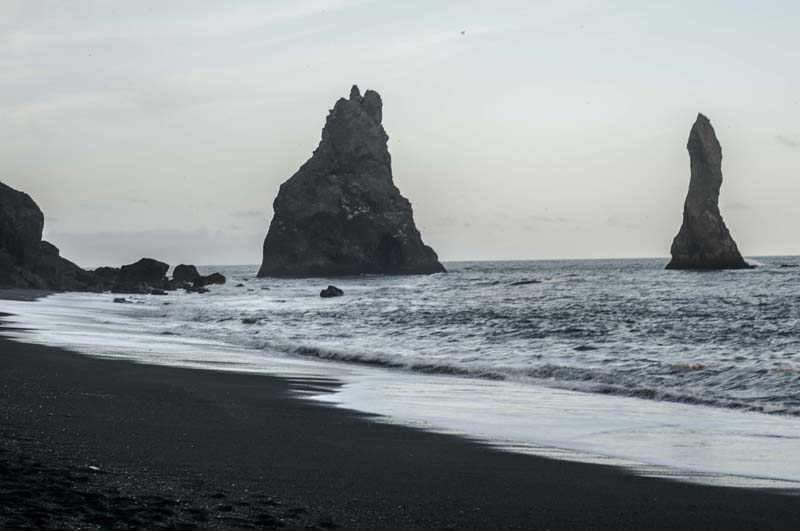
Fig 1: Basalt rock formations at Reynisfjara; commonly spoken about as a petrified troll

Fig 2: Basalt rock formations at Reynisfjara, mirrored in the Hallgrímskirkja, and the National Theater of Iceland buildings in Reykjavik
I have found such stories to be a circumpolar theme: not only in Iceland, but across Canada, and in Lapland (where I did not travel but spoke to members of the Sami peoples), features of the various species on the land and the landforms alike are extended, augmented, and metamorphosed to yield protagonist personae of their stories. It must be noted that these stories are inseparable from their spatio-temporal contexts of telling: in Iceland, for example, they were recited (often read from manuscripts) at gatherings within their domestic spaces (usually turf houses) during their long winters; or told during wayfaring, where the stories indirectly contained vital information about where to go or not go, and how to do so.
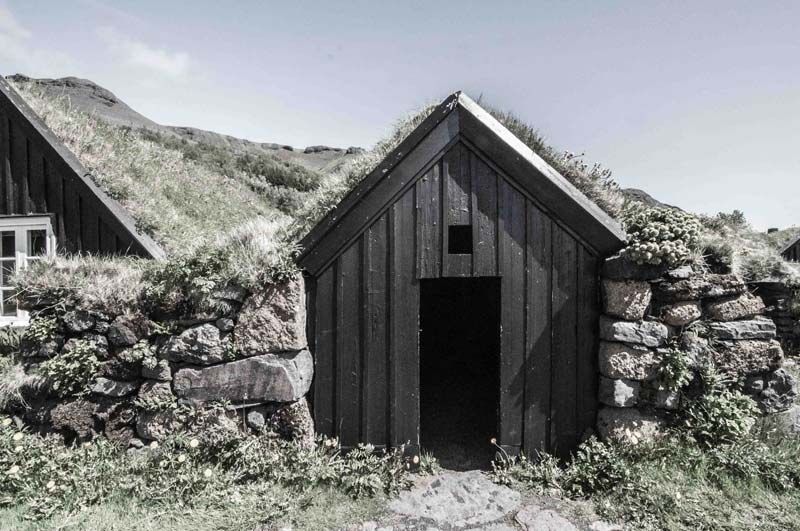
Fig 3: Reconstructed turf house complex, transported to and exhibited at the Skógar Museum, Iceland

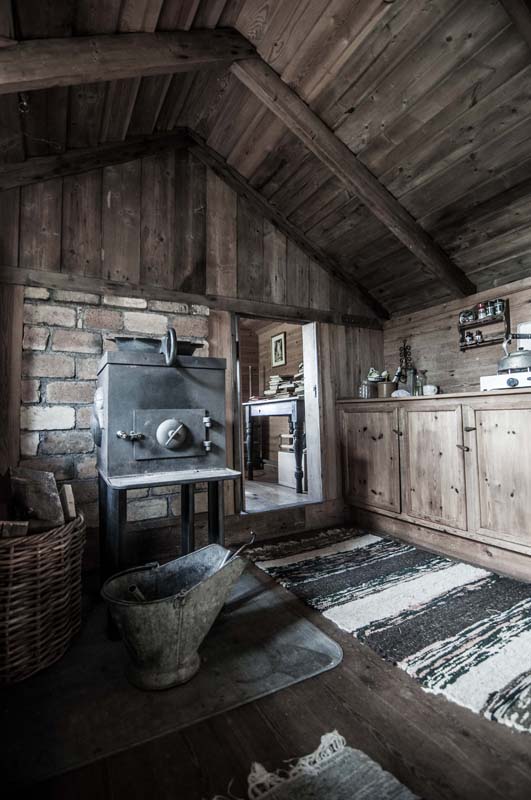
Fig 4 & 5: Interior of the main/living room at the turf house complex renovated by Hannes Lárusson, Austur-Meðalholt

Fig 6: Kitchen of the reconstructed turf house complex, transported to and exhibited at the Skógar Museum, Iceland

Fig 7: Abandoned turf house at Drangurinn í Drangshlíð
The landforms and various animate species co-exist as protagonists, as it were, in an ongoing environmental theater—where both species and spaces are brought into existence with their features shaped by (or with) constant exchanges with the other. Similarly, people from the Yukon and Northwest Territories I have spoken to have spoken about encountering tall creatures whose features were shaped by their ecosystems; and likewise people from Haida Gwaii have gestured to creatures shaped by the dynamism of the intertidal zone—or the chaw saalii in the Haida language3—that the Haida inhabited. In fact, Haida and other coastal peoples’ very conceptions of space reflects what they observe other creatures’ patterns of spatial inhabitation to be; for example, they perceive the worlds of killer whales under the surfaces of waves to be mirrors of sorts, of the spatial patterns the Haida produce. Conceptually speaking, such exchanges between places and people, the significance of which I will try to articulate further in what follows, I have found to be common themes between various regions of the sub-Arctic North. What is of importance here is not the ‘legitimacy’ of any claims of having witnessed so-called mythical creatures, but the way human behavior, society, and space are shaped about their common beliefs. Not only do information exchanges here best occur through oral language, but modeling the shaping of their information, cosmologies, and worldviews is best done by studying their oral exchanges and dispersions.
I have found these stories to be information-rich, in ways that have only recently been appreciated by various scientific communities. The stories I encountered contained archaeological information and information pertinent to environmental history that could be deciphered, so to speak, by coupling, carefully looking at landscapes with relating them back to incidents in the stories. This, too, is a northern circumpolar theme: the marriage of traditional knowledge and its means of formation and sustenance; in other words, oral epistemologies with scientific means—especially geology and archaeology. In Iceland, in the Yukon, and other parts of Canada, stories have contained vital information about not only how the lands have been shaped for thousands of years by various geological factors, but also how the ancestors of the storytellers reacted to these environmental changes and how their patterns of life, migration, and sustenance came to be.4 It must be noted that these stories are told not simply for curing intellectual interest, rather, they contain vital know-how for sustenance and for taking care of the environment. Through my travels, I have spoken to anthropologists and geologists who highlighted that it was by forming vital relationships with particular Indigenous communities that they came upon precious knowledge about both the land and the people. (Of course, many of these relationships are rather contentious as scientists have often disrespected the generosity of the Canadian First Nations and dug up their ancestors’ graves, lied about various stories for their academic glory, and engaged in other misdemeanors. I have been fortunate to speak to a few people where the relationships continue to be ones of mutual respect, and furthermore, I have been very fortunate to speak to both sides.) These stories and this knowledge deal with long durations and vast geographies, and exhibit varied knowledge-keeping methods—unlike the ‘analysis and inference’ processes of recent scientific research methods. The peoples look at the mountains, movements of glaciers and rivers, and other geographical features, and identify how times have passed differently in the various places their ancestors encountered. And although I have not been able to circumambulate the globe along sub-Arctic latitudes as originally planned, I have spoken to some members of the Sami (from Lapland) and the Inuit (from Canada and Greenland) at a circumpolar Indigenous festival in the Yukon, and finding such value in their information-rich stories appears to be very common indeed in the circumpolar North. Thus, not only are natural occurrences of various scales and magnitudes recorded by shaping protagonists in stories that correspond to them, but geological, natural, and environmental history are themselves mediated by way of oratory practice and recital.
A significant feature of this oral epistemological format is that it is evident how the information pre-exists the categories of information that we have forced knowledge into since the Enlightenment. Stories flow freely from imagination to life lessons to teaching about morality to passing on valuable skills required in everyday life. The vital presence of these stories and the contexts in which they come to be are significant parts—and indeed forms—of life itself and cannot be sheared away into measured quanta of informational material. Much of the knowledge is tacit, or even tactile. The stories thus live on somewhere between matter and mind; between Descartes’ infamous categories of res cogito and res extensa.5 Neither are categories such as form and content, or narrative and content, applicable here. Architecture, too, in such knowledge comes through not as a discipline but as a phase in the life cycle of carbon chemistry, and is intermingled with food, clothing, energy, and shelter.

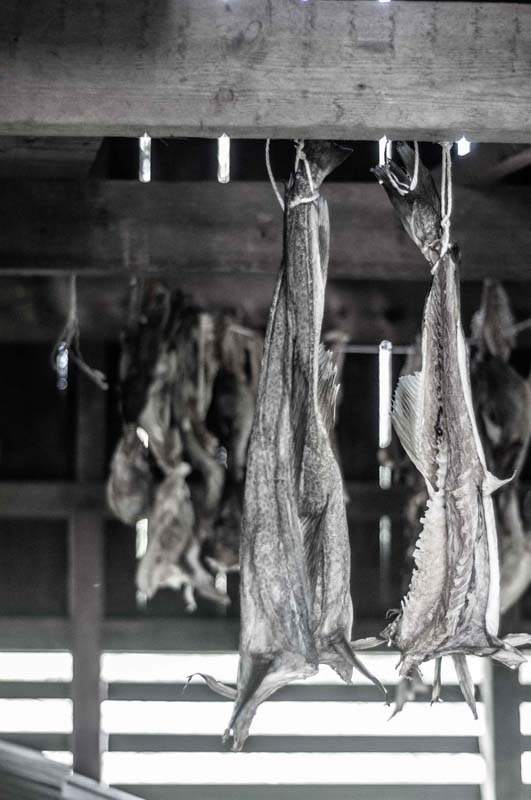
Fig 8 & 9: Hut for drying cod fish in the turf house complex renovated by Hannes Lárusson, Austur-Meðalholt. Similar buildings for processing fish have been built along the coasts of circumpolar sub-Arctic regions.
A point I want to emphasize that underlies this project is: the depth and richness of information of Indigenous knowledge come from an ethos and a culture of care invested in the survival of all species and spaces, and not from atomizing knowledge into bits of information to generate speculative value and use. And this is perhaps also why their language deployed so has (at least until recently) escaped writing and other forms of inscription that attempt to freeze language into visual and uni-sensory quantifiable forms. The imperatives toward their oral epistemology are especially prescient today, and these imperatives are precisely what we must learn from various Indigenous peoples.
Voice
Long ago · it was · she said, · my mom, · water · flooded · earth · on.
No · land · area seen.
Bald eagle · and · Raven · driftwood · on · they sat.
Fish little · and · seaweed · they eat, · that · by · they lived.6
As this short excerpt from a transcript of a tale told by Nakhela—Hazel Bunbury in the Southern Tutchone language (from Southern Yukon) shows, the deployment of language is direct, with periods and intonations punctuating long and silent, but heterogeneous durations. As is evident above, the emphasis of storytellers is often on acts or activities and objects, which are expressed in succinct phraseology. Not only did the impetus to speak come from places I was quite unfamiliar with, but with meters and rhythms strikingly particular. Unlike many a European language, where the strict grammar, sentence constructions, and other rules of language use take prominence and attention—thus, also disciplining their speakers—Indigenous linguistic experience appears to yield more tolerance, give, and dynamism. Although hardly any native speakers of these languages survive, the voice of the author has effects that I find to resonate and resound even in transcriptions—but only having witnessed the telling of some of these stories. And it is precisely the spirit of such orations and narrations that I have witnessed the elders I encountered on my trip to foster, even in their use of the English language. Catherine McClelland has discussed the role that language played for the Yukon First Nations and emphasized that it was used rather sparingly.7 Words, acts, and other symbols carried an emphasis that clued the fact that the gestures to be communicated lay somewhere just beyond the realms of the symbols used. Elders were verbose only in times when important knowledge was to be passed on, when expression was coupled with the intensity of (non-linguistic) action. Such patterns of silence, followed sometimes by enthusiastic and focused narrations, are precisely what I recognized in the conversations I have had with the Canadian First Nations. It can generally be said that language was valued because of a restraint that was usually at work, a linguistic restraint and culture of valuing that mirrors other facets of their life.
In many of the stories told, some that I witnessed directly and others that I discussed with artists and elders, the voice of the storyteller caught my intrigue. I was struck by not only the oratory patterns and acoustic resonances, but also by the positioning and authority of the narrator. Stories were often told in a ‘first-person’ voice, as if the teller was present in the (historical or mythical) time that the stories took place. The Ice Ages, for example, which I thought to be far and distant in both history and geography before my travels, I found to be ever-so-fresh in many of the stories that I witnessed—as if it had just happened! Such a notion of time is perhaps what the scholar of ancient cultures Mircea Eliade refers to as illud tempore (in ‘that time’, a mythical time that legitimizes the repetitions of a culture’s rituals and practices).8 By no means did the first-person voice stand for a transcendental force or God, but merely one who had witnessed many incidents over the years, learned the stories from their ancestors (by repeating verbatim), and thus could weave together ways of presenting best practices and modes of adapting for survival and care-taking to subsequent generations. Such a voice, in addition to conveying important information, also produces immense affect and induces a life-like presence in the very time and space of the present or recent telling of the story. It is the voice of an individual, but also of their ancestors and peoples. Tenses as well as the identity of the author are not fixed, but shift positions between various historical and present times, in accordance with the subjects or listeners being addressed. To be sure, such affects of presencing are not superadded, and neither are they representational or purely leisurely. They are the very lifeline of the peoples, since history, myth, morality, and so on, were inextricably interwoven in their stories. Such a voice is thus also how the common ground of the people is continuously sustained and reinvigorated.
The imperatives of such voicing are perhaps best discussed with an almost forgotten domain or discipline: rhetoric. However, rather than discuss the stories and knowledge using the concepts and terms of rhetoric, I want to shift slightly the discussion about the voice of the storyteller to how the rhetoric associated with such voicing operates through art. In previous reports, I have discussed numerous works of art and the conversations I have had with their creators: I am thinking of those reconstructing turf houses in Iceland and sod-houses in many parts of the Canadian North (Fig 10 & 11); of those tanning and stringing the hides of caribou and moose in the Yukon (Fig 12); of those building kayaks using dried animal hides (Fig 13 & 14); and of those carving totem poles and dug-out canoes in Haida Gwaii (Fig 15 & 16).
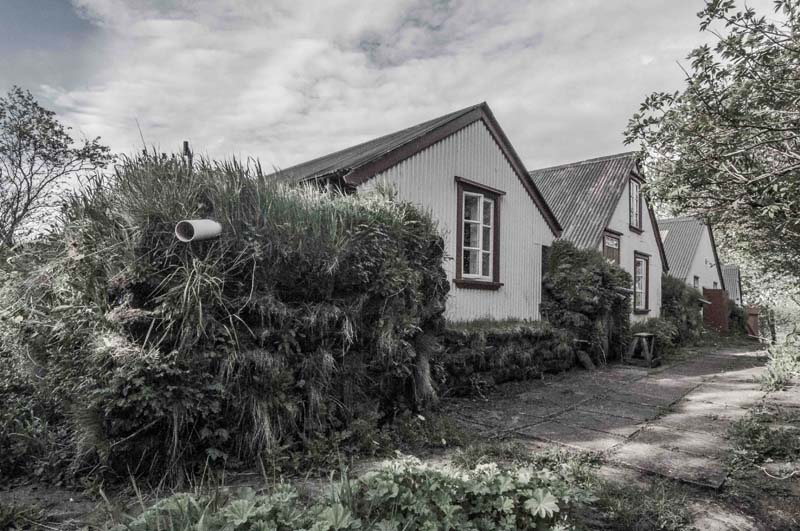

Fig 10 & 11: Turf house complex renovated by Hannes Lárusson at Austur-Meðalholt in South-Iceland
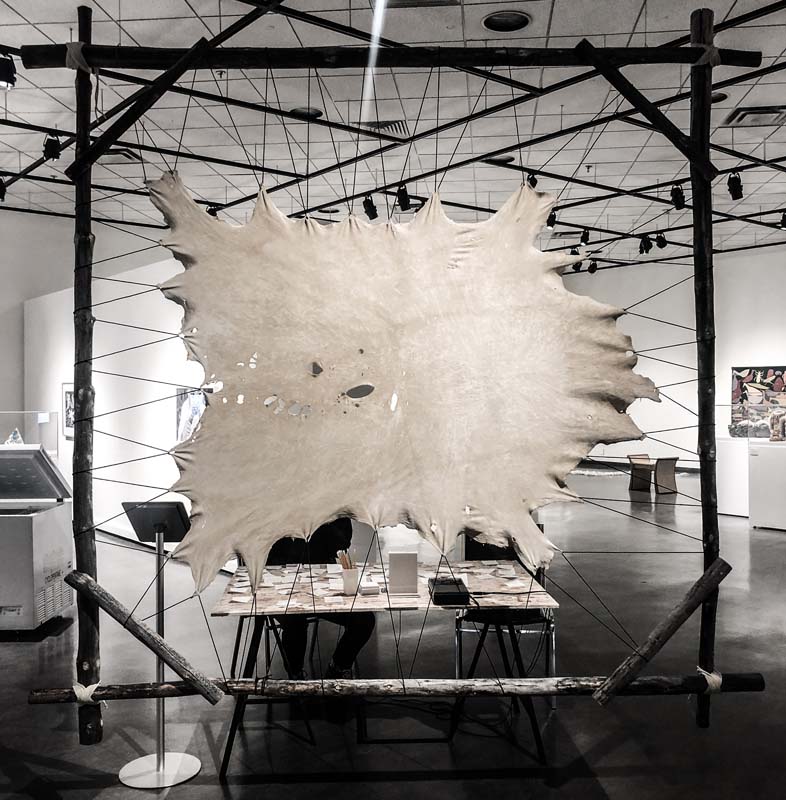
Fig 12: Vadzaih dhòh (Caribou Skin) by Copper Caribou (Montana Prysnuk and Delaney Prysnuk), exhibited at the Yukon Arts Center, Whitehorse, 2022
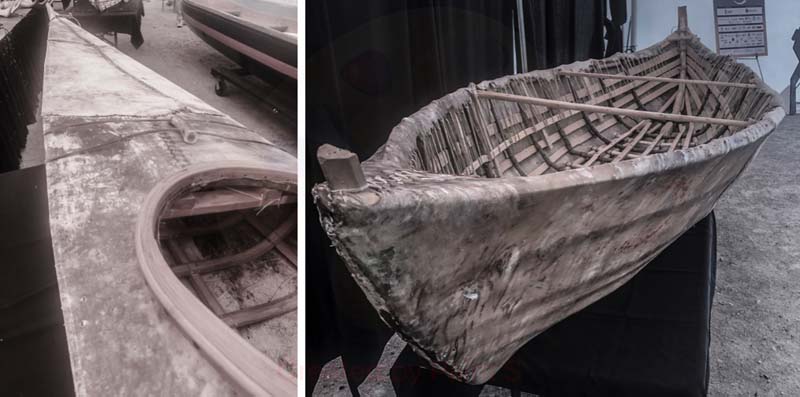
Fig 13 & 14: A kayak and canoe made from animal hide by Doug Smarch (and others) from Teslin, exhibited at the Adäka Festival 2022 in Whitehorse, Yukon

Fig 15 & 16: Formline comparison between: A Gitxsan totem pole in Gitanyow, BC, and a Haida totem pole in Old Masset

Fig 17, 18, 19: Formline comparison between: A Gitxsan totem pole in Gitanyow, BC, a Haida totem pole in Old Masset (Note the flat and fat lip. This was a symbol of a higher-ranked individual in the Haida social matrix), and a Gitxsan totem pole at the Ksan Historical village in Hazelton, BC


Fig 20 & 21: Dug-out canoes at the Haida Gwaii Museum, Skidegate.
In retrieving the tools of their ancestors, reforming contact with the sources and contexts of their materials, and attempting to (re)invent their most vital skills and know-how, are they not embodying precisely the first-person voice of a storyteller? Not only are these Indigenous artists inevitably positioned as repositories of their peoples’ knowledge—and their artistic processes being key means of retrieving further knowledge—but they also recall and collapse into the moment of artistic creation, precisely those historic and mythical times (illud tempore, as per Eliade) of their heritage. If the first-person voice and authority of the storyteller are vital in regenerating the common knowledge and conversational fabric of a peoples, is not art serving a similar role and regenerating the common skills, artistic heritage, and being a conduit to other forms of knowledge and memory? Even if rhetoric as a discipline or mode of inquiry is largely forgotten, its modes of operation are thus very much active through the artistic practices of the circumpolar North I have witnessed.
Animism and empathy
It is evident that a non-human-centric perspective is adopted in the conceptions of knowledge I have surveyed. I have hinted at this, but let us discuss it further. Significant tropes of such a perspective are animism and empathy (which I have also discussed with examples in each of my monthly SAH fellowship reports). As Mallgrave and Ikonomou have discussed in their book, Empathy, Form, and Space, ‘empathy’ emerged as a significant term, at least in nineteenth-century discourses of German aesthetics pertinent to architecture.9 In these theories, humans are described to perceive architectural and other objects by projecting upon them human-centric tropes and characteristics. As Wölfflin has suggested (in the above-mentioned book), ‘proportion’ as conceived in a Humanist framework relies on precisely such a conception of empathy and, since the Renaissance, has become tethered to the dimensions of the human body (which also has a history of being taken a bit too literally, as is the case with Francesco di Giorgio’s comparison of a sprawled-out human body to a cross church plan!)10 What is valuable in Wölfflin and the other ‘empathy’ theorists’ work is their insistence on space being not a pre-existing category of human intuition, but in fact coming into being in our very act of perception, in the dynamic and kinesthetic relations born in the moment of our seeing and cognizing that seeing. What I do find restrictive, however, is the object being limited to sculpture or architecture and the subject to humans. What about non-human animals? What about non-animal species? A further question that I have after witnessing Indigenous notions of space is: if we can see tropes of ‘human’ in buildings and other objects, how could we not extend them with human notions of care? Why is this Humanism not humane to all humans and other species? In what follows I will discuss how, in a non-human-centric worldview, the projections (of human to space) are much more complex and empathetic; how the ‘projectiles,’ as it were, of projection are not just uni-directional but form a complex web through which humans, animals, and objects/spaces interact and co-evolve.
First, unlike Western conceptions of neutral or homogenous space, the spaces that we are dealing with here are not understood in the abstract, but rather, quite directly from the various animal organs out of which objects of daily use were made.11 I highlighted in prior reports, how the Yukon First Nations used the intestines of moose and caribou as vessels to store in, and their stomachs used as vessels to boil and cook in. These organs and membranes have astonishing plasticity and variances, and these properties are evident in the peoples’ very conceptualization of space. The geometry that they work with is astoundingly complex, dealing with topologies of both curvature and flexibility. The knowledge of how to work these surfaces is very much tactile—and even tacit—and propagated by being practiced communally. Along the Arctic circle, the Inuit often used whale bones as structural skeletons for their own shelter. These were usually covered with animal hide. In the case of the Haida, and other peoples influenced by the dynamism of littoral zones, the geometry of marine animal bodies, seashells, and so on influences their conception of space. Not only is the initial conception of space highly influenced by the topology of the animal body that is (re)discovered in each act of harvesting, but (and especially in the case of the whale bone structure, which also involves enveloping human bodies with animal hides and furs) humans ‘place’ themselves within the animal bodies they consume. Furthermore, the spatial conceptions of various Indigenous peoples are not simply influenced by the internal spaces of animals, but also by the ways in which they observe shoals/herds/groups of animals to pattern and produce space. And to zoom out a magnitude further, both the animal and human body and relations between various species do not occur in a closed system, but are dynamic and changing as shaped by environmental factors. What happens within an animal body is a reflection of what occurs outside, and vice versa. This is evident in many Indigenous cosmologies, for example, for the Sami people from Lapland, the arterial network of reindeer is seen as analogous to their river networks, both of which are key sources of nourishment. I must also note here, as I did in my report on the Yukon, that harvesting an animal did not imply a lack of respect for the animal; in fact, as much of the literature I have discussed in that report shows, relationships between animals and humans are historically and environmentally complex where agency has been relegated equally to animals and humans in various instances.12 I also discussed how humans have not only taken from animals, but also given much; for example, Indigenous peoples harvesting herds of reindeer while also protecting them from other predators—an exchange that various First Peoples believe to be understood and acknowledged by the herds.13 Another point that must be emphasized is that the above notions of space are low on content that can be easily and permanently visualized; rather, they persist somewhere between common and tacit knowledge, tactile memory, and orally-transmitted (yet multi-sensorial) comprehension. Thus, complex relations and topologies of hunter and hunted, consumer and consumed, and outside and inside emerge here. And evident through the notion of empathy is a deep and holistic, information-rich understanding of the various entanglements between human, animal, and environment.
Finally, such an understanding of empathy does not exclude flora or inanimate objects. In Iceland, for example, the turf houses involve the roots of grass or turf interlocking after the laying of blocks of topsoil and turf to form walls. The structural stability of the buildings depends on life or nature itself to continue its processes upon and into the turf houses. Indigenous peoples in Canada practice a different dimension of empathy involving trees, where they are treated not only as natural resources to be used, but as archives of environmental history. The peoples decipher from their trees the history of the climate, the conditions of the land, and patterns of migration of various species (including humans), to mention a few aspects. This information was vital in deciding which parts of the lands or waters to inhabit and tend to, where materials could be harvested in ways that would benefit the land, and so on. Relationships were developed with each tree as it periodically yielded pitch, bark, resin, and many other resources. The uniqueness and personality, as it were, of each tree was understood. In harvesting trees for any artifacts, such as canoes and totem poles (in the case of the Haida and the Tlingit speaking tribes of the Yukon, British Columbia (BC), and Alaska), the characteristics of trees played an important role in its transformation into its subsequent life form—where ‘life form’ refers to the animated spirit each artifact was attributed to have. For example, in the making of a coastal Tlingit and Haida dug-out canoe, logs are first floated on the water, and the design of the canoe depended on how the log would float. No two canoes could be the same, as no two trees were the same. Furthermore, the connection of each canoe, totem pole, etc., to where it came from is never severed, as the story of its coming into being is shared in stories to be repeated through generations. Here, not only are sophisticated forms of mnemonics at work, but they simultaneously emphasize relationships of care and empathy, while also augmenting the richness of the language, know-how, and stories of the people.

Fig 22: In-progress portions of the turf house complex being renovated by Hannes Lárusson at Austur-Meðalholt (focus on the interlocking roots of turf that bond the blocks of topsoil together)


Fig 23 & 24: Trees at the Naikoon Provincial Park
Networks of information flow
Although my previous reports have been focused on specific peoples and the lands and waters they inhabited, there has been much information exchange between them. For instance, the connection of the Haida and coastal Tlingit to the inland Tlingit in the Yukon (the Teslin Tlingit First Nation) and northern BC (Atlin Tlingit First Nation). These exchanges are evident in not only the trade networks set up between them—which were further expanded in the last two or three centuries by British traders—but also in the formations of First Nations, tribes, and clans through the languages that consolidated. For example, the inland Tlingit First Nations were highly influenced by their coastal counterparts and the sub-marine cosmologies of the latter are hence evident in their boat making, acoustic instruments such as drums, and their shelters. The language maps, as it were, hence mirror exchanges in the skills, methods, buildings, and arts of the peoples of a region. Such maps are common (oral) knowledge, which have recently also been visualized, for example, the widely circulated maps of the Yukon Indigenous languages.
Many of these exchanges, and the differences in the worldviews of the peoples can be observed in the various versions of their common stories. For example, in this story told across Yukon, northern BC, and Alaska:
After Crow made the world, he saw that sea lion owned the only island in the world.
The rest was water—he’s the only one with land.
The whole place was ocean!
Crow rests on a piece of log—he’s tired.
He sees sea lion with that little island just for himself.
He wants some land too so he stole that sea lion’s kid.
“Give me back that kid!” said sea lion.
“Give me beach, some sand,” says Crow.
So sea lion gave him sand.
Crow threw that sand around the world.
“Be World,” he told it. And it became the world.14
In this origin story featuring the raven (or crow), depending on where and by whom the story is told, the other characters and details change. For example, in the versions told by the inland First Nations, the sea lion is replaced by a gull, and other elements also reflect the specific peoples’ lay of the land. What remains common in the many versions of this story, is that the narrator affects not a ubiquitous transcendental (or god), but a witness of sorts, one who simply happens to be around various acts of creation. Another common theme is the trickster persona of the Raven, who, in playing tricks for seemingly trivial gains, accidentally gets involved in various creative or originary acts. The accidental nature of much that happens is thus highlighted. In the region this story spread, there are several other commonalities: for example, skills such as boatbuilding, drum-making, and the building of longhouses, most of which were transferred from the coast to inland—whereas skills related to the skinning of animals and producing hides, furs, and so on transferred from inland to the coast. I highlighted in my report on the Yukon, how methods of treating, stretching, and stringing animal hides were common to building kayaks, drums, and tents—and how these led to the artifacts even exhibiting similar aural properties.

Fig 25, 26, 27, 28: An animal hide canoe made by Doug Smarch from Teslin, exhibited at the Adäka Festival 2022 in Whitehorse, Yukon; Drums from various Canadian First Nations, played at the Adäka Festival 2022 in Whitehorse, Yukon; Vadzaih dhòh (Caribou Skin) by Copper Caribou (Montana Prysnuk and Delaney Prysnuk), exhibited at the Yukon Arts Center, Whitehorse; An animal hide tipi erected at the Kwanlin Dün Cultural center in Whitehorse, for the Adäka Festival 2022
A significant commonality that persists among Indigenous peoples is the complete absence of the notion of waste. Every part of the animal body harvested is put to some use, and this has also proven to be a stellar source of ingenuity and innovation. The artwork, kayaks, dug-canoes, and longhouses of First Nations with inland Tlingit heritage in the Yukon and northern BC make for interesting examples not only as they form nodes, both geographical and cultural/linguistic between the geographical extremities of the regions discussed, but also as they exhibit exchanges between the domains of transport, music, ritual and celebration, and shelter.
In the case of the longhouses of the region, common methods of orienting and building them are found. As well, in most cases, the lack of separation between domestic and sacred space is common, and the longhouse is thus generally a monadic space. Of course, a significant way in which longhouses differed from each other was the materials available, for example, only on Haida Gwaii could one find 300-foot cedar trees (which the Haida also gave second lives to as totem poles and canoes). Smaller trees led to longhouses of lesser spans and depths, as well as to different proportions, dictated especially by the angle of the roof.

Fig 29: Haida longhouses at the Haida Gwaii Museum, Skidegate

Fig 30: Gitxsan longhouses at the Ksan Historical village in Hazelton, BC

Fig 31: Carcross/Tagish First Nation longhouses at the CTFN Cultural Center
Yet, the spatial matrices of the coastal longhouses can be observed in those built inland. As discussed in detail in my report on Haida Gwaii, but consider now as general properties of the spatial axes/matrix of longhouses of the region: the archetype of its horizontal axis involves the weather approaching across the water, through the length of the longhouses, to the forests behind; whereas the archetype of its vertical axis includes the root cellars or caches for storing food, its fire pits and smoke-holes, the stilts where applicable, adjacent totem poles, and surrounding trees spiraling upward.15 The axes of such a spatial matrix are not origins in their space-making processes (like the three-dimensional Cartesian axes or matrices of many Eurocentric spatial conceptions), but rather, are non-visual archetypes that recur in their production of space, informed by their common knowledge, cosmological models, and epistemologies, and transmitted through their stories not only to their younger generations, but also across the lands and waters.
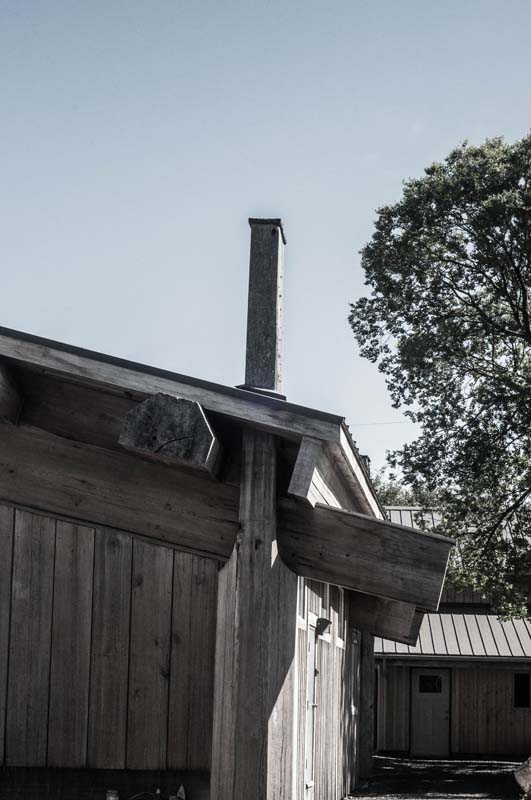
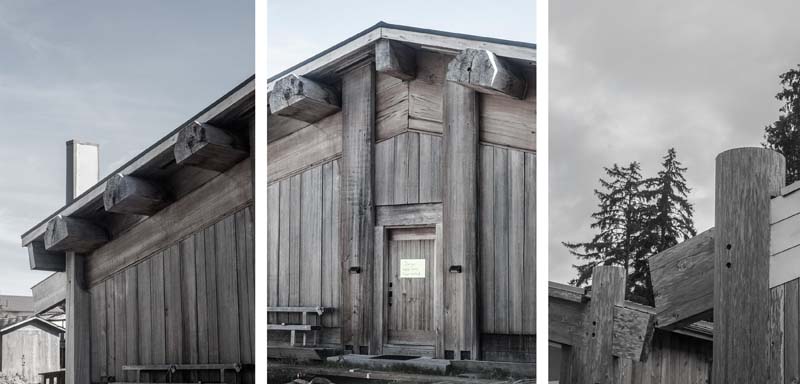
Fig 32, 33, 34, 35: Construction details of a (nearly complete) Haida longhouse in Old Masset
Concluding remarks
I must begin to conclude by stating my infinite gratitude to the Society of Architectural Historians and to the committee of the H. Allen Brooks Travelling Fellowship for making these travels possible. Not only have I discovered new ways of traveling—staying in places for longer durations and seeking out people for multiple visits and conversations—but I have also discovered new methods of research and writing. I must confess that this essay is not a historical or an anthropological endeavor. I never aspired to legitimize information in the ways of the institutional sciences or even social sciences. Even history, and especially an oral history, can easily suffer the lack of trust when not evidenced by stuff found in dusty archives or heavily footnoted to gain legitimacy from other existing histories. The information here lies somewhere in between received know-how; consonant theories and attitudes to adopt in building, researching, and traveling; and aspirations for worldviews and attitudes to be explored further.
Generally speaking, in the various stories of these First Nations, and indeed in my conversations with them, I have thoroughly enjoyed the casuality, colloquialism, and incredible leeway for topics to seamlessly drift. After all, is this not one of the wonders of orality: that one can shift between thoughts and sentences, topics, intensities, and emotions? Broken and grammatically incomplete sentences often seem not only fitting but at times even more informative. And these are often not closures or completed understandings of matters but rather questions and openings in the knowledge that only probe further and deeper than one might have previously imagined.
I must make a few other concluding remarks about Indigeneity in a Eurocentric world. In the last few decades, much progress has been made in Canada in empowering Indigenous First Nations as well as in other places across the circumpolar north to make amends for centuries of misdoings by the colonizing powers. However, numerous other Indigenous peoples continue to not be acknowledged even today, with little respect given to their ways of life, wisdom, traditions, and heritage. Even among the peoples I have visited in Canada, there are disparities in how amends have been made, and a comparative framework of travel has made these clear. (I will not refer to specific peoples here at the risk of imparting information that is not mine to share.) Despite this, generally speaking, in the Canadian North, wonderful efforts are underway by many First Nations to return themselves to self-governance and to practice their traditions (hunting, trapping, fishing, etc.), many of which they have been denied for many decades. Efforts are also underway in attempting to regenerate their languages, which colonial powers had barred them from speaking, causing severe generational ruptures of knowledge transfer. And as I have discussed, Indigenous artists are supremely important conduits of regeneration, as they renew their traditional art forms by reinvigorating lost methods and even integrating them with contemporary ones. So although most conversations today about becoming whole again and cultural regeneration inevitably begin with residential school experiences, there is also much hope, enthusiasm, and effort expressed in the regeneration of traditional activities, languages, and, importantly, art. An inductive research method such as mine opens one up to the common conversational fabric of the regions I have visited, and thanks to the generosity of the wonderful people I have spoken to, I have been able to grasp a little bit of what it means to regenerate entire civilizations.
Finally, I must comment that any history reflects, first and foremost, not an objective account of past events or facts, but rather, the shifting concerns and exigencies of the present it is written in. Hence, my plea to listen to the oral histories of the Indigenous people is also a plea to holistically address issues of decolonization, ethnic and spatial equity, and cultural and architectural preservation. I hope that some of the Indigenous methodologies, imperatives, and cultures of care that I have gestured to can be infused into the mainstream of architecture, both in architectural history and practice. Indigenous stories must be ‘listened to’: an effort to listen and understand Indigenous methods is indeed to decolonize, to responsibly globalize—and to apologize.
Endnotes
1 Louis Althusser, “Ideology and Ideological State Apparatuses,” in Lenin and Philosophy and Other Essays (Monthly Review Press, 1972), p162–174.
2 Walter J Ong, Orality and Literacy: The Technologizing of the Word (London and New York: Routledge, 1982), p7–11.
3 “The forest, sea, and sky (…) None of these is the human realm. Humans are only at home on the chaaw salíi, [translated as “the place where the tide has been”] the boundary or intertidal zone, at the conjunction of all three. A few strokes of the paddle or a few steps into the bush are enough to leave the human world behind."
See Robert Bringhurst, A Story as Sharp as a Knife: The Classical Haida Mythtellers and Their World, 2nd ed., vol. 1 (Vancouver/Toronto/Berkeley: Douglas & McIntyre, 2011), p157.
4 For such themes in Iceland, see Emily Lethbridge, “Digital Mapping and the Narrative Stratigraphy of Iceland,” in Historical Geography, GIScience and Textual Analysis (Springer, 2020), p19–32;
and Emily Lethbridge and Steven Hartman, “Inscribing Environmental Memory in the Icelandic Sagas and the Icelandic Saga Map,” PMLA 131, no. 2 (2016): p381–91.
5 To be fair, I must note that I am here using Descartes as a strawman of sorts. These conceptions, like many other popular philosopher’s concepts are oversimplified and used in popular intellectual discourses, and this often not only leaves out important nuances but also distorts their meanings and implications.
6 Kwanlin Dun First Nation, Kwanlin Dün: Dä́kwändür Ghay Ghàkwädīndür--Our Story in Our Words (Figure 1 Publishing, 2021), p42–45.
7 Catharine McClellan, Part of the Land, Part of the Water: A History of the Yukon Indians (Toronto: Douglas & McIntyre, 1987), p110.
8 Mircea Eliade, Cosmos and History: The Myth of the Eternal Return (New York: Harper and Brothers, 1959), p20–21.
9 Harry Francis Mallgrave and Eleftherios Ikonomou, eds., Empathy, Form, and Space: Problems in German Aesthetics, 1873–1893 (Getty Center for the History of Art and the Humanities, 1994).
10 See Heinrich Wölfflin, “Prolegomena to a Psychology of Architecture,” in Empathy, Form, and Space: Problems in German Aesthetics, 1873–1893 (Getty Center for the History of Art and the Humanities, 1994).
11 For detailed descriptions of many more traditional acts, skills, and methods, see McClellan, Part of the Land, Part of the Water: A History of the Yukon Indians (Toronto: Douglas & McIntyre, 1987)
12 Citations included in the report on Yukon include: the introduction of Tim Ingold, ed., What Is an Animal? (Routledge, 2016), and; Tim Ingold, “From Trust to Domination: An Alternative History of Human-Animal Relations,” in Animals and Human Society (Routledge, 2002), p13–34.
See also: Norman Alexander Easton, “‘It’s Hard Enough to Control Yourself; It’s Ridiculous to Think You Can Control Animals.’ Competing Views on ‘The Bush’ in Contemporary Yukon,” Northern Review, no. 29 (2008): p21–38; Paul Nadasdy, “The Gift in the Animal: The Ontology of Hunting and Human–Animal Sociality,” American Ethnologist 34, no. 1 (2007): and; Marcel Mauss, The Gift: The Form and Reason for Exchange in Archaic Societies (routledge, 2002)
13 See Bathsheba Demuth, “Reindeer at the End of the World,” Emergence Magazine, July 5, 2020, https://emergencemagazine.org/essay/reindeer-at-the-end-of-the-world/
14 From an origin story of the land, as told by Angela Sydney to Julie Cruikshank. See Julie Cruikshank, Life Lived like a Story: Life Stories of Three Yukon Native Elders (Vancouver: UBC Press, 2002), p42-44.
15 In addition to my report on Haida Gwaii, see George F MacDonald, “The World Is as Sharp as a Knife: An Anthology in Honour of Wilson Duff,” in Cosmic Equations in Northwest Coast Indian Art, ed. Wilson Duff, 1977; Here, pertaining to the Haida's cosmic distributions along the vertical axis, he gestures to the five layers of the cosmos above the “sky door” or smoke-hole of their longhouse, as well as five levels in the underworld.
See also: George F MacDonald, Chiefs of the Sea and Sky: Haida Heritage Sites of the Queen Charlotte Islands (UBC Press, 1989). MacDonald explains how non-human animals consonantly describe the Haida’s conception of space through axes and zones, the three primary divisions being: the strata of the underworld (creatures below the ground and the sea); the middleworld (creatures that live in the forest); and the upperworld (aerial creatures).



Leave a commentOrder by
Newest on top Oldest on top